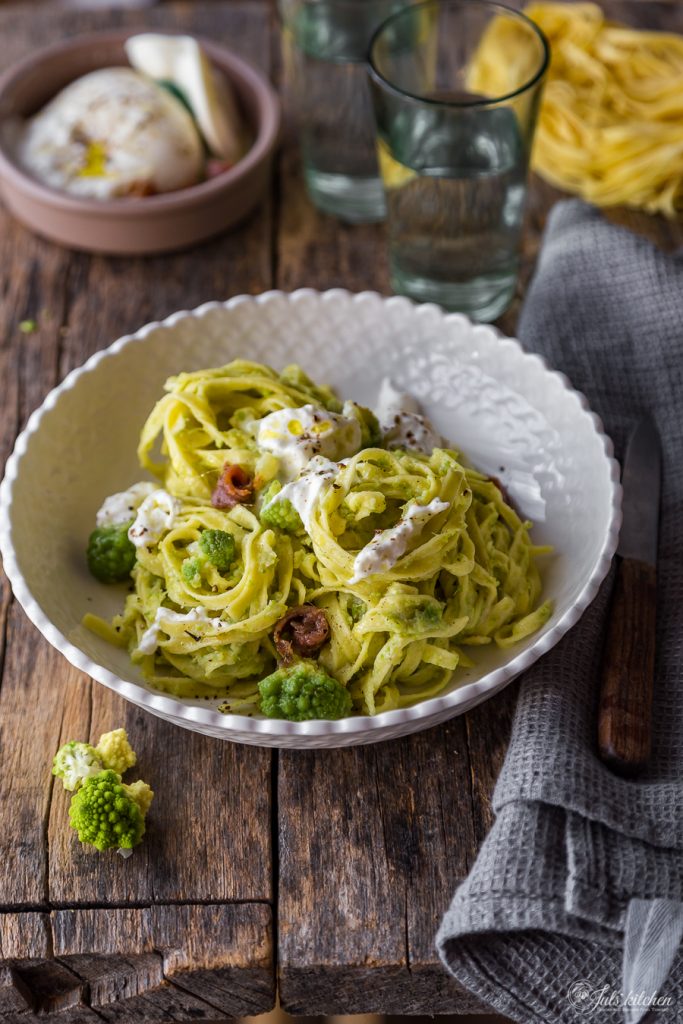Italians, pasta and a plate of tagliatelle with romanesco broccoli
Everything you see I owe to spaghetti. – Sofia Loren
Have you ever thought about the idea that we Italians give of our lives abroad? Reflect for a moment on what you think is our normal daily routine in terms of eating. Meeting many foreign travellers during the cooking classes helped me realize that there is a romanticized view of what our eating and cooking habits are. Most of the time this interpretation does not correspond to the evolution that brought us, for good and evil, to live a faster and pragmatic life.
Take for example the structure of the typical Italian meal, where an appetizer opens up a tight progression of different courses, all rigorously served in different plates. How many people nowadays eat like this? How many have really eaten like this in the past, especially in the countryside? During our weekly lunches with grandma, on her table this traditional sequence is still kept alive, as a plate of pasta is always followed by a main corse based on meat or fish, one or two side dishes where vegetables are the protagonists and some fruit. She also insists on changing the plates at every course and she almost apologises when she skips the pasta in the menu: she has stamped on her DNA the ancient idea of a hospitality that required to feed and cuddle, that was measured on the number of courses served, a moral obligation to tick all the boxes of a classic Italian menu.
On Sunday, when we gather as a family and we eat all together, we find a comforting and reassuring habit in following the very same structure of the meal. On a daily basis, though, when in the evening you have to prepare dinner after more than ten hours of work, when lunch is the only break in a succession of tasks and deadlines, our meals tell a very different story.
Most of the time I choose a main dish – either pasta, barley, brown rice, legumes, eggs, meat or fish – and I serve it with lots of vegetables. It is a matter of time efficiency, but it is also due to a more sedentary life which requires a light, balanced and digestible meal. Sitting back at your desk after a canonical old fashioned meal would be counterproductive, not only for work productivity.

Life is a combination of magic and pasta. – Federico Fellini
The same can be said for pasta. You can’t even imagine how many times I have been asked if we Italians eat only fresh pasta made from scratch. Rolling out the dough with a rolling pin on a lightly floured wooden board, making pici just with your hands, folding neatly the tortelli: how much poetry lies in these gestures. These activities anchor you to your safe place, they link you to a line of country cooks, but the artisanal skills of making fresh pasta do not hide anymore a daily routine of repeated gestures.
I asked grandma, 89 years old and still cooking up a storm in the kitchen, and she assured me that fresh pasta was not a daily matter. During the Second World War, in this village of fifty souls that I’ve always called home and where today there are just houses, vegetable gardens and chickens coops, there used to be a ballroom, a political club, a bowling ground and a tiny grocery store that would sell loose rice and pasta. There was little choice, just penne or spaghetti. You would choose your favourite shape and then you would bring your pasta home, neatly wrapped in the yellow paper. Grandma would make homemade pasta from scratch once or twice a week, tagliolini, or tagliarini as she calls them. She would do this because living in the countryside had the pros of having daily fresh eggs from your chickens and flour stocked in your pantry, she would make fresh pasta for her family and for the priest of the village, she would make it especially for the broth. The other days were all about soups, polenta or dry pasta.
My mum also remembers that in the ’60s, in San Gimignano, the loose pasta was sold in a small grocery store, where you could choose your favourite shape from the wooden drawers of a large cupboard.

In our family tradition the fresh pasta is made from scratch when there is something to celebrate, for Christmas or a Sunday gathering with relatives and friends. On the other occasions, we all buy dry pasta – without feeling guilty! – choosing the shape that best suits a certain seasoning or sauce.
Opening the pantry door and finding some packs of pasta waiting for you is reassuring, it means that in less than half an hour you can cook a good meal, choosing those ingredients that will become the dressing of your pasta inspired by tradition, creativity, seasonality or simply by what you have in your pantry and in your fridge. This has always been my favourite way of cooking, as the scarcity of available ingredients is stimulating, pushing you to create something good with what you have.
Lately I opt for lots of vegetables, a good olive oil and just a few more ingredients to turn my pasta dish into a whole meal. I close my laptop, call Tommaso and set the table: in a short time the steaming pasta is spooned into the plates for us to celebrate a well deserved pause as a modern Italian couple: chatter and Netflix!

Tagliatelle with romanesco, anchovies and burrata
I teamed up with Luciana Mosconi, an Italian pasta company with an artisanal soul, to create today’s recipe. They asked me to develop simple every day recipes with a traditional allure, something that perfectly represents my favourite way of cooking where the protagonists are the seasonal ingredients.
The first outcome of our partnership is a seasonal dish of tagliatelle with romanesco, anchovies and burrata, something that lately appeared often in our weekly menu. I am sure it will be soon featured in yours, too.

Let’s have a closer look at the ingredients featured along with the tagliatelle in this winter pasta dish. The main protagonist is the romanesco. You can substitute it with cauliflower or the more common broccoli, although I find that this wonder of nature, the romanesco, so wonderful in its fractal conformation, has also the most delicate texture and creamy taste compared to the other cruciferous.
As for the burrata, the fresh Italian cheese from Apulia that looks like a mozzarella with a filling of creamy deliciousness, it can be replaced with stracciatella or small pieces of mozzarella torn with your hands. I have to admit, though, that the burrata holds has a special place in my heart: taste it, simply drizzled with a fruity olive oil, and you’ll understand why. Either you choose burrata or mozzarella, the important thing is to add it at the very last moment, as its role in the balance of the dish is not only to add a milky creaminess to soften the salinity of the anchovies and the taste of cabbage, but also to create an interesting contrast of temperatures. Think a scoop of gelato and a steaming espresso, to a scorching hot pizza with a cold dollop of mascarpone… Another reason to eat immediately this pasta dish without further hesitation.
Anchovies, chili and garlic – a well knit team – are those three ingredients that, even if used in small quantities, give a resolute character to the dish, adding that kick of salinity and spiciness that the romanesco needs.
Tagliatelle with romanesco, anchovies and burrata
Print Recipe Pin Recipe Share by EmailIngredients
- 500 g of romanesco
- Extra virgin olive oil
- 1 clove of garlic
- Chili pepper
- 4 anchovy fillets preserved in oil
- 125 g of burrata
- Salt
- 250 g of tagliatelle
Instructions
- Blanch the romanesco florets in a large pot of salted boiling water for about 10 minutes, then drain them and run them under cold water to preserve the colour. Put them aside.
- Heat in a non-stick pan a few tablespoons of extra virgin olive oil with the finely chopped garlic and the anchovies. Add chilli pepper to your taste. Cook on the lowest flame.
- When the anchovies have dissolved into the olive oil, add the romanesco florets and cook until they begin to collapse into a sauce. Season with salt, if necessary. Just remember that the anchovies are already quite salty.
- Cook the tagliatelle in a large pot of salted boiling water, drain when al dente and pour them into the pan with the romanesco. Add the burrata torn in pieces with your hands, toss and serve immediately, as long as you can appreciate the contrast between the hot pasta and the cold burrata.

Link Love
Now it is your turn to tell me everything about your relationship with pasta, being it fresh, homemade, dry or eaten in a restaurant. In the meantime, there are some interesting links to read and comment!
- Old but good, a post on the blog about the Italian spirit and the pomarola, the Italian tomato sauce.
- Another old post on Italian culture and vegetables.
- Romanesco: Cooler Than Broccoli, Maybe Even More Delicious from bon appétit. It looks like miniature Christmas trees and tastes like broccoli. Yep, we’re into romanesco.
- Two recipes from Rachel Roddy, which knows how to cook with broccoli. A twice-cooked broccoli recipe direct from Rome and pasta with broccoli and sausage.
- My take on pasta with broccoli.
- Pasta with romanesco, pine nuts and grana from Valentina Hortus for Cucina Corriere.
- How to make pasta like the Italians by Laura Santtini
- Ten golden rules for cooking pasta like the Italians, from an artisan pasta maker on The Local. A very good way to lose friends in Italy is to mess with pasta. Fiddling with the tried and trusted Italian methods can also affect the taste of the dish, but many foreigners don’t even realise their technique is unorthodox.
- Veteran food blogger David Lebovitz on his new book and Bay Area beginnings. A very interesting reading for every food blogger or food enthusiast.










Mi piace il tuo website, la ricetta di pasta sembra buonissima. Peccato che qui in Uruguay non habbiamo gli ingredienti necessari, per esempio la burrata non esiste, nemmeno il romanesco. Mia mamma, italiana, viveva nelle Marche, in un piccolo paese in campagna, e facevano tutto a casa durante la guerra. Le tue ricette e storie mi sono dunque familiari. Un saluto da Montevideo
Wonderful post and photos! It’s late, and me and my wife have eaten, but this recipe had me salivating.
Pasta. I remember the first time I ate midnight pasta after coming back to my friend’s house in Torino after performing a show in the surrounding area. It must’ve been 2am. He put out cheese, olives, and preserved melanzana, and then proceeded to saute garlic and chilies in olive oil, while he put a pot of water on to boil. The aroma of garlic and chilies filled the kitchen while I greedily wolfed down olives and pecorino. I was astonished that, with the addition of some grated pecorino, such a simple dish could be so sublime.
Years later, I made midnight pasta for the first for a beautiful girl who would eventually become my wife. Indeed, life is a combination of magic and pasta. And love!
LC
P.S. Just discovered your website, and it takes me immediately back to bella Italia. Grazie Mille!
Love love love this recipe! Made for the 7th time today, however I often use green asparagus instead of romanesco. Thanks so much!